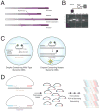Somatic mosaicism: implications for disease and transmission genetics
- PMID: 25910407
- PMCID: PMC4490042
- DOI: 10.1016/j.tig.2015.03.013
Somatic mosaicism: implications for disease and transmission genetics
Erratum in
- Trends Genet. 2016 Feb;32(2):138
-
Erratum to: Somatic Mosaicism: Implications for Disease and Transmission Genetics.Trends Genet. 2016 Feb;32(2):138. doi: 10.1016/j.tig.2015.07.004. Epub 2015 Dec 22. Trends Genet. 2016. PMID: 29482722 No abstract available.
Abstract
Nearly all of the genetic material among cells within an organism is identical. However, single-nucleotide variants (SNVs), small insertions/deletions (indels), copy-number variants (CNVs), and other structural variants (SVs) continually accumulate as cells divide during development. This process results in an organism composed of countless cells, each with its own unique personal genome. Thus, every human is undoubtedly mosaic. Mosaic mutations can go unnoticed, underlie genetic disease or normal human variation, and may be transmitted to the next generation as constitutional variants. We review the influence of the developmental timing of mutations, the mechanisms by which they arise, methods for detecting mosaic variants, and the risk of passing these mutations on to the next generation.
Keywords: mosaicism; postzygotic mutation; recurrence risk; somatic mosaicism; transmission genetics.
Copyright © 2015 Elsevier Ltd. All rights reserved.
Figures




References
-
- Seshadri R, et al. Mutation rate of normal and malignant human lymphocytes. Cancer Res. 1987;47:407–409. - PubMed
-
- Gong Y, et al. The influence of premeiotic clusters of mutation on indirect estimations of mutation rate. Human Heredity 2006 - PubMed
-
- Erickson RP. Somatic gene mutation and human disease other than cancer: an update. Mutat Res. 2010;705:96–106. - PubMed
Publication types
MeSH terms
Grants and funding
LinkOut - more resources
Full Text Sources
Other Literature Sources

